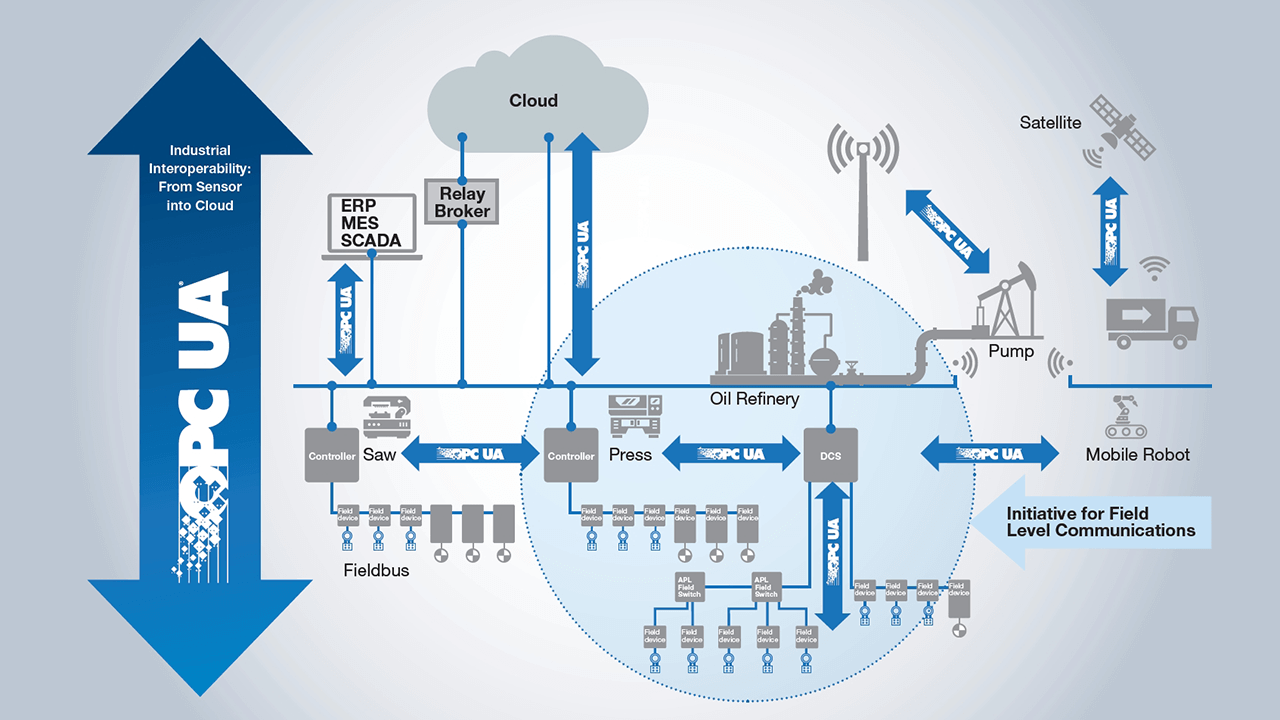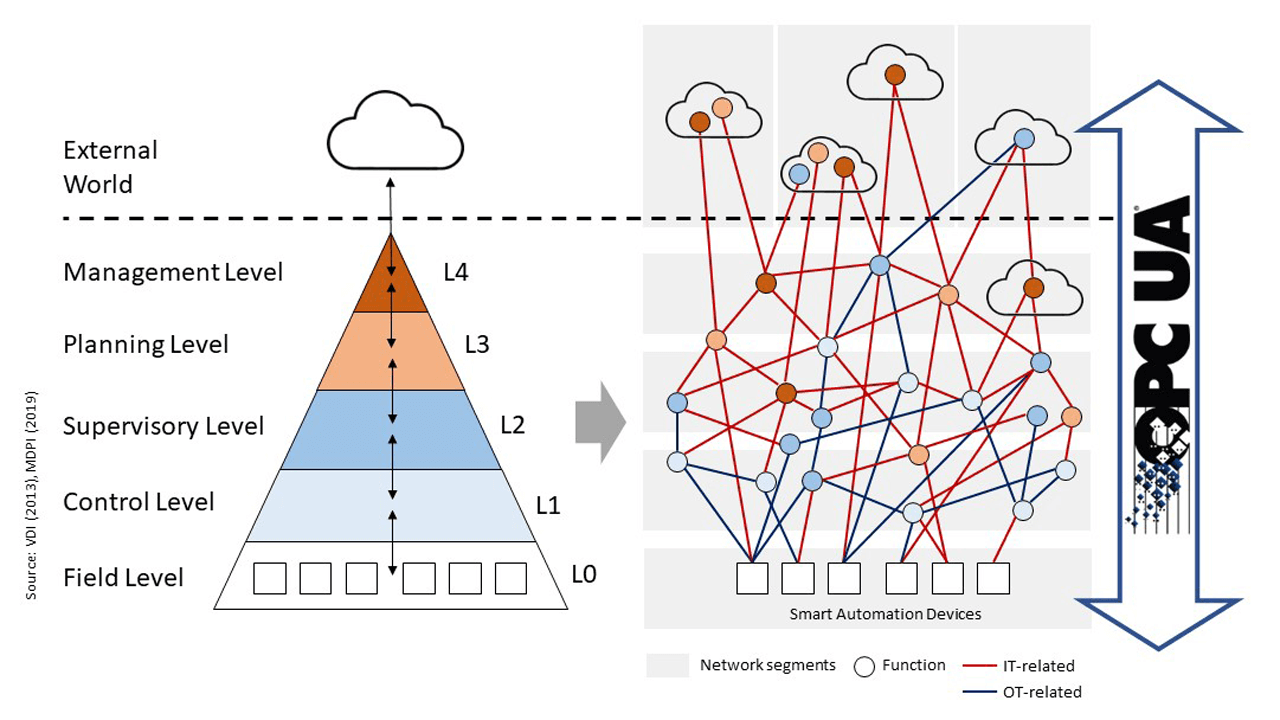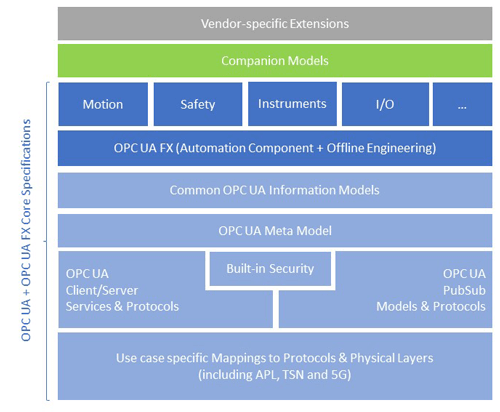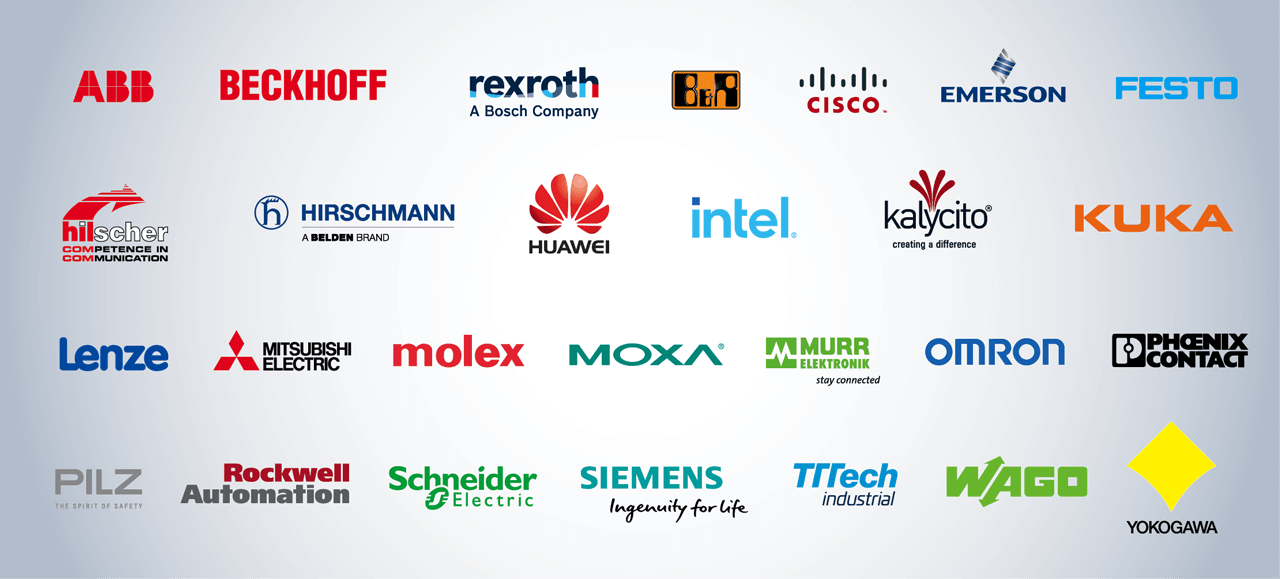TechnologyJune 1, 2021
OPC UA – from automation pyramid to information network

The OPC UA (IEC 62541) framework with the extensions for field exchange (OPC UA FX) specified by the FLC Initiative, in combination with underlying communication technologies such as APL, TSN and 5G, offers a complete, open, standardized and interoperable solution.
The Field Level Communications initiative has reached a major milestone. OPC UA FX extends OPC UA to the field including APL, TSN and 5G technologies.
Introduction
A little over two years after its launch, the Field Level Communications (FLC) Initiative of the OPC Foundation has completed the first release candidate (RC1) of the OPC UA FX (Field eXchange) specifications supporting the horizontal communication between shop floor systems, including the exchange of real-time and safety-critical data between controllers (e.g. PLC, DCS) in a vendor-independent way.
This marks an important milestone to further develop OPC UA as a uniform and manufacturer-independent industry interoperability solution that fully scales from field to cloud, including communication and information exchange at the control and field level. For this, OPC UA is taking advantage of enabling communication technologies, such as Ethernet-APL (Advanced Physical Layer) Ethernet TSN (Time-Sensitive Networking, as well as 5G mobile networks.

OPCF Vision
FLC Initiative: goals/achievements
In November 2018 the FLC initiative was founded under the umbrella of the OPC Foundation. A total of 27 companies, including the largest automation manufacturers in the world, have joined the initiative’s Steering Committee and support it financially as well as with man-power and technical know-how.
The common goal is to expand the scope of OPC UA to the field level and to establish OPC UA as a uniform and consistent communication standard in factory and process automation. In the technical working groups, which are open to all members of the OPC Foundation, a total of over 300 experts from more than 60 companies are currently working together in order to develop appropriate concepts and specifications.
Work on the first version of the specification has made good progress – despite Covid-19 and the associated restrictions. The basic concepts for the use case Controller-to-Controller (C2C) have been developed and have been incorporated into a first set of specifications. The first release candidate (so-called RC1) has been completed and is now used to implement prototypes and to execute interoperability testing in order to validate the specifications. At the same time, test specifications are being generated which will later be converted into corresponding test cases for the OPC UA Compliance Test Tool (CTT).
In a second version of the specification, the already developed concepts will be extended for the use cases Controller-to-Device (C2D) and Device-to-Device (D2D), which will then enable that OPC UA can be used as a uniform and consistent communication solution for vertical and horizontal integration, including field, edge and cloud.
This opens up completely new possibilities, especially with regard to the various Industry 4.0 and IIoT use cases and application scenarios which target to make the production more efficient and more flexible.
OPC UA solution for the field level

OPC UA Framework with extensions for Field eXchange (FX) .
OPC UA Framework
The field extensions specified by the FLC Initiative are based on the OPC UA Framework (IEC 62541), which enables a secure and reliable, manufacturer and platform-independent information exchange.
Controllers and field devices support both, the connection-oriented client/server communication model and the publish/ subscribe extensions, which are indispensable for communication at the field level due to the corresponding requirements for flexibility, efficiency and determinism. The security mechanisms specified in OPC UA are also used, which, among other things, support authentication, signing and encryption of the data to be transported and can be used for both client / server and publish / subscribe communication relationships.
OPC UA FX – Extensions for Field Exchange
The first release candidate of the FLC Initiative consists of four specification parts (OPC UA Parts 80-83) and focuses on C2C communication (Controller-to-Controller) for the exchange of process and configuration data by means of peer-to peer-connections and a basic diagnosis. These parts are labelled with OPC UA FX (Field eXchange):
- Part 80 (OPC UA FX 10000-80) includes an introduction and provides an overview of the basic concepts for expanding OPC UA for communication with and at the field level.
- Part 81 (OPC UA FX 10000-81) specifies the basic information model for controllers and field devices (automation components) and the communication concepts to meet the various use cases and requirements of factory and process automation.
- Part 82 (OPC UA FX 10000-82) describes network services such as topology detection and time synchronization.
- Part 83 (OPC UA FX 10000-83) describes the data structures for the exchange of information required for offline engineering using descriptors and descriptor packages.
In addition, a 40-page technical paper was published that explains the overall vision and the technical approach.
OPC UA Safety – fail-safe communication based on Profisafe
Work on the safety solution for OPC UA (OPC UA Safety) is also very advanced. A first OPC UA Safety specification based on client-server mechanisms was developed by a Joint Working Group with Profibus & Profinet International (PI) and was already published in November 2019 (Part 15, OPC 10000-15).
A revision of the OPC UA Safety specification will be available shortly, which describes the extensions for OPC UA Pub/Sub and the parameterization of safety devices including C2D (controller-to-device). OPC UA Safety supports a maximum user data length of 1500 bytes, the creation of any network topology (star, line, grid, …), hierarchical safety IDs for simplified management of series machines and dynamic connection setup with changing partners, such as modular machines, Autonomous Guided Vehicles (AGVs), Autonomous Moving Robots (AMRs) and tool changers, etc.
OPC UA Motion based on Sercos and CIP Motion
Progress can also be reported with regard to OPC UA Motion. A working group has started in Mid 2020 to develop an OPC UA-based motion solution comprising of motion control functions for various types of motion devices such as controllers, standard drives, frequency converters and servo drives.
The FLC Steering Committee has agreed to base the work on the CIP Motion and Sercos specifications and to adapt them to the OPC UA information modeling and system architecture, taking into account the relevant Industry 4.0 and IIoT use cases. The fact that, as with safety, existing concepts and specifications are being used, the specification work can be significantly accelerated.
OPC UA with APL, TSN and 5G
OPC UA is much more than a protocol. Instead, it is an industrial framework which is fundamentally transport-agnostic and therefore can be easily adapted to different transport layers depending on the application-specific requirements and use cases.
By making use of a universal Quality-of-Service (QoS) modelling concept, which includes real-time communication capabilities with guaranteed bandwidth and low latencies, information and services can be easily mapped to different underlying transport protocols and physical media with their particular QoS mechanisms.
For OPC UA FX two communication profiles are defined. One is mapping the OPC UA protocol (UADP) to UDP/IP. The other one is directly mapping UADP to Layer 2 Ethernet resp. Ethernet TSN. The latter option is being used to reduce the protocol overhead and to increase the protocol efficiency for demanding automation applications, such as Motion Control or High-speed I/Os.
Key technologies for bringing OPC UA to the field level are Ethernet-APL (Advanced Physical Layer) and Ethernet Time-Sensitive Networking (TSN). But OPC UA applications will not be bound to wired Ethernet technologies only. Wireless communication standards, such as 5G or Wi-Fi 6/7 support similar QoS guarantees and are therefore also supported in the future.
The combination with APL
Ethernet-APL describes a physical layer for Ethernet that was specially developed for the requirements of the process industry. Ethernet-APL enables data transmission at high speeds over long distances, the supply of energy and data via a common, twisted 2-wire cable and protective measures for safe use in hazardous areas.
This makes Ethernet-APL the enabling technology for the use of OPC UA and other Ethernet-based protocols in the process industry. Due to the special importance of this technology, the OPC Foundation joined the Advanced Physical Layer (APL) project group in June 2020 to develop and promote APL together with other non-profit organizations and various industrial partners.
The combination with TSN
By using Ethernet TSN, deterministic data transmission via OPC UA is facilitated, which is particularly indispensable for demanding automation applications. In addition, TSN allows different applications and protocols to be operated using a common network infrastructure based on open standards. This enables convergent industrial automation networks to be implemented in which various IT and OT protocols can coexist.
A working group of the FLC Initiative is currently identifying which TSN sub-standards are mandatory for OPC UA-based end devices and infrastructure components in order to meet the specified requirements for performance, flexibility and ease-of-use.
The OPC Foundation has given a clear commitment to the TSN-IA (Industrial Automation) profile, which is being developed by the IEC / IEEE 60802 working group. For this reason, the OPC Foundation has entered into liaisons with the standardization bodies IEC SC65C and IEEE 802.1.
The combination with 5G
Data exchange via OPC UA is not limited to wired or wireless Ethernet communication. Support for the 5G mobile communications standard is also on the OPC Foundation’s roadmap. For this, the OPC Foundation has been working on concepts to include 5G in its Quality of Service (QoS) modelling concept to enable the seamless integration of 5G into the existing OPC UA architecture. Furthermore, a cooperation with the 5G Alliance for Connected Industries and Automation (5G-ACIA) has recently been established, in order to identify and leverage the synergies of combining OPC UA with 5G with the goal to support Industry 4.0 & IIoT applications with a reliable and at the same time flexible communication solution.

The member companies of the Steering Committee of the OPC Foundation’s Field Level Communications (FLC) Initiative.
Summary and conclusion
The OPC UA (IEC 62541) framework with the extensions for field exchange (OPC UA FX) specified by the FLC Initiative, in combination with underlying communication technologies such as APL, TSN and 5G, offers a complete, open, standardized and interoperable solution that not only fulfills the requirements of industrial communication, but at the same time enables consistency and semantic interoperability from the field level to the cloud and vice versa.
With this approach – and by adopting additional device companion specifications that are developed by numerous organizations all over the world – information is made available with a standardized semantics directly at the data source, if possible: A flow meter for example offers directly standardized “OPC UA flow measuring data” as soon as the APL cable is plugged in.
And analogously, servo drives directly process standardized “OPC UA drive setpoints” and provide standardized “OPC UA actual drive values” as soon as they are integrated into a machine network with Ethernet TSN.


